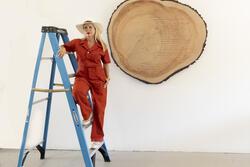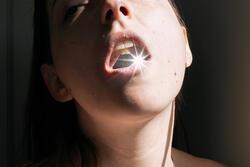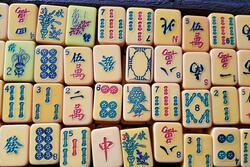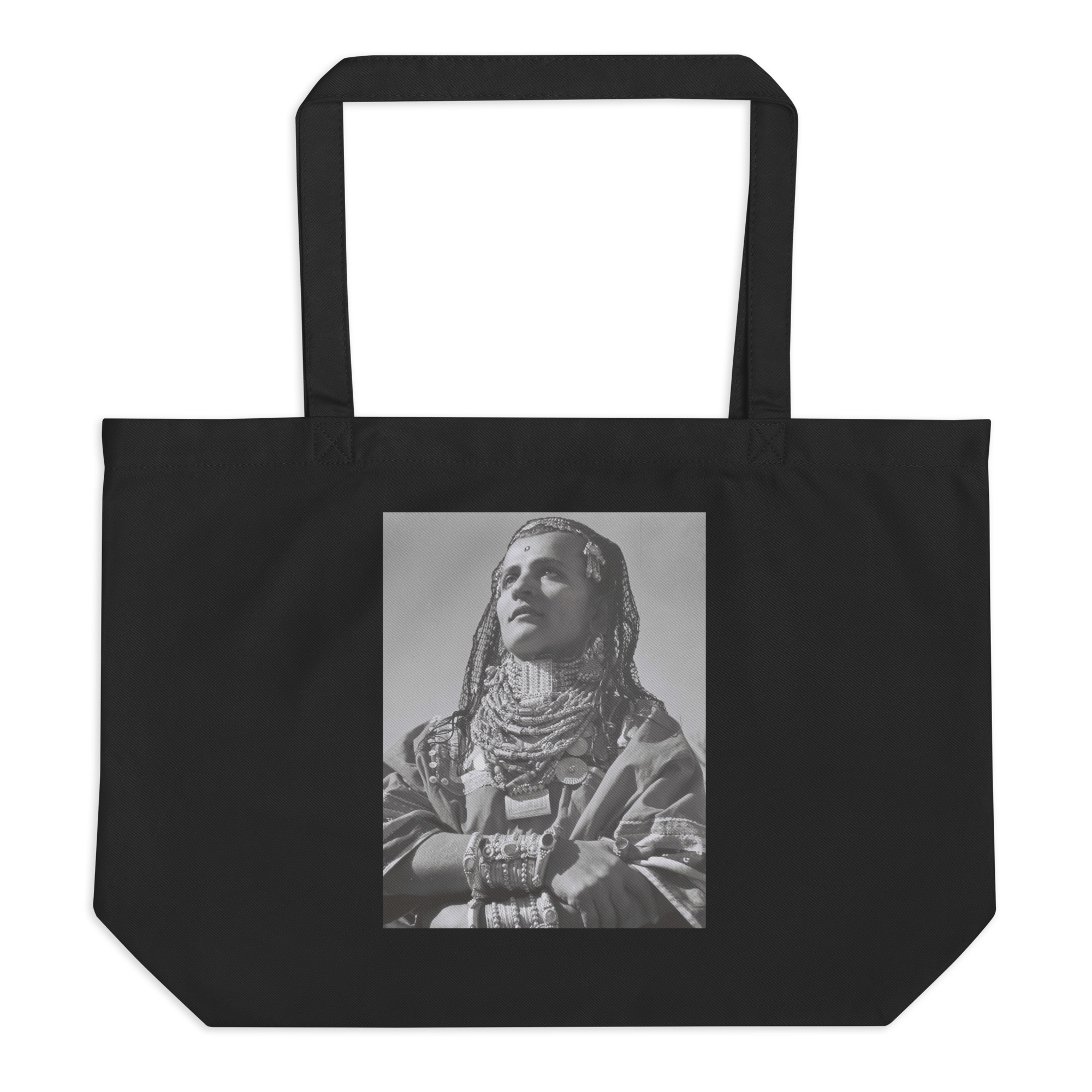7 Questions For Artist Evie Metz
JWA chats with multidisciplinary artist Evie Metz about recurring motifs in her work, making the familiar unfamiliar, and 613, her new five-foot-tall pomegranate sculpture.
JWA: Tell our readers about your artistic practice, which spans across sculpture, photography, video, and animation.
Evie Metz: I am a visual storyteller who moves fluidly between sculpture, animation, photography, and installation, allowing intuition and ideas to guide the materials and methods each work requires. My work explores the transformation of body, spirit, and narrative through a symbolic and often surreal lens. I create immersive environments that invite viewers, whether within a gallery space or through a screen, to move through cycles of identity, memory, growth, and renewal.
Recurring motifs in my work — pomegranates, ants, archetypal feminine forms — are drawn from ancestral stories and ancient traditions. I see these elements as contemporary vessels for cultural memory and personal mythology. My identity is foundational to my practice, shaping not just the content but also the ethics behind it. I draw deeply from inherited imagery, values, and modes of thought, and I see this perspective as one of heightened empathy and spiritual attentiveness. At its heart, my practice is a search for meaning through materials, metaphor, and movement, a way of asking how we carry the past forward while remaining open to change.
JWA: Your artist statement says your work “explores the cycles of life and the values of human existence.” Do these themes connect to your Jewish upbringing?
EM: Jewish thought, ritual, and storytelling are deeply rooted in cyclical time, layered symbolism, and the interconnection of body, land, and spirit. These ideas have deeply influenced how I approach art, not only through autobiography, but through archetype.
In Jewish tradition, transformation isn’t linear, it’s recursive, always in dialogue with what came before. My work grows from this conceptual soil, rooted in values of memory, impermanence, offering, and return.
JWA: Your recent installation at the True F. Luck Gallery in Richmond, VA featured a five-foot tall pomegranate, a traditional Jewish symbol of fertility and knowledge. What drew you to this symbol and representing it in this large-scale medium?
EM: This installation featured a five-foot-tall pomegranate sculpture, eighteen ants carrying pomegranate seeds, and a large-scale feminine figure in a backbend pose embroidered with a phrase passed down through generations in my family: “Your body is your temple.” A 2D animation was projected into a corner, where characters undergo magical metamorphoses as they cross the threshold between two walls.
The pomegranate sculpture, titled 613, draws from the traditional idea that the fruit holds 613 seeds, symbolic of the 613 mitzvot. I was drawn to the pomegranate not only for its classical associations with knowledge, fertility, and abundance, but also for its resonance as a symbol of Jewish joy, resilience, and spiritual depth.
This body of work was born from a desire to honor our people’s enduring capacity to create beauty and find joy, even in the face of adversity. In times of collective grief or uncertainty, I wanted to offer an experience grounded in hope, continuity, and celebration.
By rendering the pomegranate on a monumental scale and displaying it split open on a pedestal, I sought to emphasize both its sacredness and its vulnerability. The exposed interior becomes an offering, an act of radical generosity. It reflects what I see at the heart of Jewish peoplehood: something expansive, intricate, and resilient beyond measure.
JWA: Where does your artistic impulse come from? What other symbols, secular or otherwise, are you drawn to?
EM: My impulse to make art comes from paying close attention to the world around me. I’m inspired by everyday objects and encounters, fragments of language, gestures, forms, that feel quietly meaningful.
While my work often unfolds through surreal or impressionistic imagery, it’s grounded in real experience. For instance, I once photographed a simple white bakery box on an orange counter, tied with a string. It’s a quiet image, but to me, it holds a universe, inviting curiosity, memory, and longing.
I believe art has the power to make the familiar unfamiliar, and in doing so, expand our sense of what is possible. Much of my work plays with this concept of defamiliarization, a literary term from Russian theorist Viktor Shklovsky, which involves presenting the everyday in strange or poetic ways to deepen our perception of it.
I’m drawn to symbols that carry multitudes, things like mirrors, seeds, arches, water, animals. I rework and reinterpret them through a contemporary lens, inviting viewers to engage not just visually, but emotionally and spiritually.
JWA: You’ve created some stunning stop-motion animation, which is a notoriously delicate and slow-moving process. What have you learned from working on stop-motion, especially in our fast-paced culture?
EM: There’s something truly magical about stop-motion, the way life is breathed into still objects through meticulous, painstaking performance. It is slow, yes, but that deliberate slowness creates an intimacy I find deeply meaningful, one that I believe viewers instinctively sense and connect with.
Every frame bears the trace of the human hand. That presence is part of what keeps me tethered to the process, even when it’s challenging. I build everything from scratch: the characters, the worlds, the gestures.
As I’ve grown as an animator, I strive to balance professionalism with the presence of the human hand. I don’t always erase the imperfections, the cracked clay, the loose stitch, the moments when something wobbles or frays, because these nuances bring honesty and life to the work. I embrace them as evidence of living, breathing presence. By the end of each film, the characters are worn and tired, their skin cracked, seams loosened, mirroring our own vulnerability and reminding us that transformation always comes at a cost.
JWA: How have you built an artistic practice over time?
EM: My practice has grown through a blend of curiosity, persistence, and experimentation. I learn by doing, making mistakes, exploring new materials, and striving to answer questions that often feel unanswerable. Each project teaches me something. Often, I finish a piece with a new set of skills or a deeper understanding of a recurring question. That sense of discovery keeps me moving forward.
I’ve never been confined to a single medium. I follow the idea first, then choose the material that best serves it. That approach has led me across printmaking, ceramics, sculpture, video, photography, and animation, and allowed my work to grow in complexity and texture. Ultimately, my practice is rooted in inquiry, asking what it means to be alive, to change, to remember, and to belong.
JWA: Which Jewish artists have inspired you?
EM: Bob Dylan’s restless creative spirit, the poetic vision of Leonard Cohen, and the intuitive sequencing of Maya Deren’s experimental films have all shaped my understanding of what art is capable of. I’m drawn to the lyrical photography of André Kertész, the inventive interplay of past and present symbolism in Mark Podwal’s illustrations, and the mythic sensibility embedded in the ceramic sculptures of Mary Frank. I’m continually amazed by the animation duo Tom & Hani, whose work is exquisitely executed, soulful, tender, and profound.
What I feel connects all of these artists, and what I strive for in my own practice, is a kind of creative excavation: an effort to make sense of what resists understanding. Their work holds space for the existential, the mysterious, and the ancient, while remaining deeply present. Whether through language, image, sound, or movement, they remind me that Jewish creativity is a living thread, expansive, rooted, personal, and collective all at once.








Was this Q-and-A assembled through correspondence or is it based on a face-to-face interview?